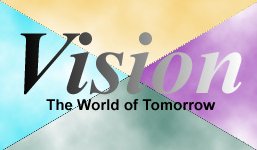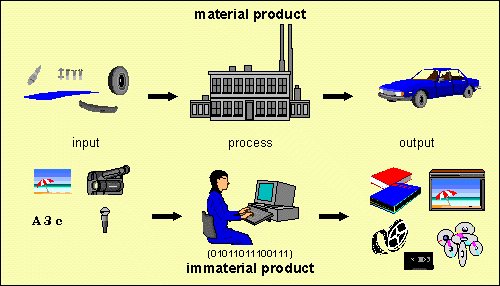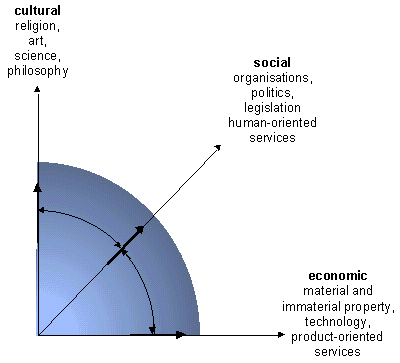
Vision
1.1 A New Socio-economic Revolution? |
1.1.1 The Industrial Revolution
In order to obtain a better idea of the way in which IT will influence our society in the coming years, we will draw an historical parallel with the Industrial Revolution in Europe and the United States of America, which started 200 years ago and has since determined the growth of the western economies. The invention of the steam engine, towards the end of the Eighteenth Century, was literally the driving force behind the beginning of this revolution. Around 1800, the first factories emerged for the mechanised production of goods. In farming and also in mining, the steam engine caused an increase in production and a change in production methods. New transport facilities emerged by applying the steam engine in locomotives. Railways created the possibility to transport raw materials and goods over land quickly and in great quantities.
Until 1870 the steam engine was used mainly to mechanise existing production processes. Between 1830 and 1870 the railways went through their first expansion. The main cities, factories and mines were connected to the railway network.
Between 1873 and 1896, there was a period of lesser economic growth. An important reason for this was the transition to a more integrated application of the new technology. This called for great investments for the expansion into a full railway network and the construction of new factories, blast furnaces and mines. Governments everywhere were stimulating private investments and often took charge of railway construction themselves. Besides this, working methods and the organisation of work needed to change. Railway companies and factories became much larger organisations than people had ever known. As a result, hierarchy became the main principle of control in the organisation. This enabled people to co-ordinate and control the work in such large organisations.Since 1896, the industrialisation of the western world has grown increasingly fast. As a result of the growth of transport, the networks of suppliers of raw materials, manufacturers and consumers of products are expanding, nationally at first, and internationally later on. A factory no longer needs to be situated near its suppliers and its customers. Manufacturers are buying their raw materials and selling their products all over the world. This opens up new market opportunities, with respect to both sales and purchasing. The number and the size of factories is growing rapidly. Numerous other technological inventions, such as electricity, cars and aircraft, only have accelerated the growth. Industry and all the services that go with it, such as trade, transport and banking, oust farming from its position as the main employer. Traditional forms of society subside and gradually make way for the modern, individualised society. As a result of economic growth and improved methods of organisation, prosperity grows. Matters such as medical care, education and housing improve, so that the general sense of well-being grows.
1.1.2. The Present Situation
The situation we find ourselves in today with respect to IT and the economy, bears a significant resemblance to the situation between 1873 and 1896.
Steam engine and microprocessor
The steam engine provided mechanisation of the production of food and other material products. The computer, or rather the microprocessor leads to the large scale ‘mechanised’ production of new, immaterial products, for example text in documents, sound on CDs, images and sound on videotapes and computer entertainment software.
Through automation, the computer ‘mechanises’ routine jobs in data processing, especially in clerical processes. Furthermore, the computer supports the design and control of industrial processes.Transport and telecommunications
Railways and waterways and later on also cars and aircraft improved the transport of food, goods and people.
The growth of telecommunications into a Digital Highway enhances the possibilities for the transfer of immaterial products between people. It also allows for direct communication between people without the need to travel physically.Changing organisational forms
The Industrial Revolution was partly facilitated by the transition from small-scale, autonomous organisations with limited mutual co-operation to large scale, strictly co-ordinated hierarchical organisations. Currently we are dealing with a reversed transition, from large scale hierarchical organisations to small-scale, autonomous organisations. The difference, however, is that these smaller organisations are now co-operating in large scale networks of organisations. Complex products, costly product development, increased customer-orientation, enhanced flexibility and contracting out are all reasons for companies to intensify co-operation and at the same time become smaller.
IT is an important facilitator in this transition. The computer and telecommunications mainly support the co-ordination and control of activities. This is ‘real automation’: not just automation of operational tasks, but the use of the computer to support people in controlling complex organisations. As a result, with IT we are now much more capable of controlling large and complex organisations than we used to be in the past.From replacement towards integration and transformation Between 1873 and 1896, technology, the basis for the Industrial Revolution, was developing from stand-alone applications to integrated applications. This would change the world dramatically.
At present, IT is still applied as a replacement for people and equipment, but integration of IT and telecommunications is now in progress. This will eventually result in a world-wide network of computers, a development similar to that of the railway network. The integration of IT and telecommunications will also lead to the co-operation between suppliers of media, hardware, software, consumer electronics and telecommunications services, similar to the development of the co-operation between transport and industry. We can conclude from this that the next phase – the radical transformation of organisations and society because of IT – is only just beginning.
1.1.3 The World Of Nonmatter
IT and telecommunications bring about a new socio-economic revolution. Like the steam engine and the railway in the nineteenth century, they contribute to the improvement and intensification of existing industries and to the creation of new businesses.
This effect is caused by the fact that IT and telecommunications support immaterial industries. In the material world, production processes revolve around the processing of raw materials into material products and around the production of food. People basically must have the right physical skills for the jobs. Machines support people with the work.
In the world of nonmatter, processes revolve around the processing of nonmatter in the form of data. People must have the right mental skills to do the work. Data are immaterial ‘raw materials’. Immaterial products are for example the contents of a book, text in a document, sound on a compact disc, representation of data on a monitor. Computers support people with processing these data.

Figure 1.1 Matter versus nonmatter The two worlds show a significant relationship. Almost everything that we create, we have first conceived of in the immaterial world, and much of it we have also discussed with each other. Ever since people learned to write and draw, they have recorded data on their actions. This way, certain knowledge can be preserved and reused. In the immaterial world we make the material world understandable, constructable and controllable for ourselves.
Matter versus nonmatter
In the material world we have to deal with shortages of raw materials and energy and with environmental pollution. Material products are subject to wear and tear. In the immaterial world there is no shortage of data. Data can be copied unlimitedly. Conceiving of and producing the contents of newspapers, books or films requires a great deal of mental effort, but little material energy and raw materials. Data can also be subject to ‘wear and tear’. Data may fade if the bearer of the data is damaged and the bearer itself may even perish completely. The meaning of data may also sink into oblivion. Take hieroglyphics, for example, or binary data on out-dated computer tapes. Sometimes the meaning can be retrieved through decoding. There are also forms of ‘pollution’ in the immaterial world. Take the use of jargon, for example, or the blurring of concepts, or the recording of inaccuracies. The greatest pollution of all is the current overwhelming supply of immaterial products, something many regard as information terror, because they have lost the overview and the understanding and are unable to derive useful information and knowledge from the enormous supply .In the material world we have to deal with wealth and poverty because we do not succeed in equally dividing goods among all people. In the immaterial world this need not be such a problem, since data can be copied unlimitedly. This makes it much more easily to distribute. At the moment, we still have to distribute immaterial products in the form of data on material bearers such as books and compact discs. In the near future, however, suppliers will be able to place the contents of electronic ‘documents’ at everybody’s disposal through a world-wide network of computers.
Let us use this opportunity to make these documents accessible to all people in a way that provides them with both overview and understanding. In this way it can be prevented that after the present gap between haves and have-nots of material products, there will also be a gap between knows and know-nots of immaterial products.Mechanisation and automation of the production of nonmatter
Computers and telecommunications will increasingly support people in producing, storing and transmitting immaterial products in the form of electronic documents. We ‘mechanise’ the production of nonmatter by automating the routine jobs in the process. This implies an enormous expansion of our capacity to produce, store and distribute all kinds of knowledge and information. With the computer, we are also better able to design, control and monitor processes in both the material and the immaterial world.The support of productivity in the immaterial world has important consequences:
Increase of material productivity
In industry, agriculture and retail, distribution and transport, computers and telecommunications enable people to better design highly complex products and to adapt and control the required processes of production, transport and sales.Increase of immaterial productivity
With IT, organisations in the financial , media, social and medical care, science and government sectors can improve their services and products with respect to both quality and quantity. Companies in the media sector can develop and produce new products, such as multimedia products, to be used for example in education, art and entertainment. They can offer these products to consumers all over the world via the network. The main issue with immaterial products is, after all, not mass production but mass distribution of products.Opening up a world-wide immaterial world
The advancement of telecommunications will result in a world-wide network in the form of a Digital Highway connecting the computer systems of companies and private individuals. An increasing number of people can be reached anywhere with mobile equipment. A world-wide immaterial world thus emerges, in which people communicate and produce immaterial products which they offer to each other. In the immaterial world there are no distances. Through the network, people can reach other people and computers all over the world and therefore have ‘ears and eyes’ everywhere, have their ‘say’ everywhere. The current developments in for example the world-wide Internet network show the birth of ‘global villages’ of people communicating with each other, phenomena that appear to be facilitated by IT and telecommunications.The nonmatter revolution
If the parallel we made with the Industrial Revolution proves to be valid, in the near future we will see a nonmatter revolution, leading to new business, especially in the form of production and distribution of immaterial products. We consider the much used term ‘Information Revolution’ to be less suitable, since this socio-economic revolution involves the expansion of data in the form of all kinds of immaterial products rather than just an expansion of the production, storage and distribution of data that serves as information for other people. It particularly concerns the social, economic and cultural consequences of this expansion.The kick-off of the immaterial industry already happened at the beginning of this century. Radio, television, film and the record industry have grown as a result of the production of nonmatter. When we buy a compact disc, we do not primarily pay for a piece of plastic, but for its immaterial contents: a set of bits arranged in a specific way. A CD player renders a piece of music by converting the bits into sound.
In the immaterial world we can create imaginary realities. This used to be the territory of artists, such as musicians, narrators and writers. The novel The Lord of the Rings, by J.R.R. Tolkien, a tale of initiation, is a good example of the elaboration of a great imaginary reality in the form of a book.
New media open up new possibilities in this matter. The Walt Disney Company have produced animation films since the thirties. Future historians will probably regard Disney’s first major animation, Snow-white and the Seven Dwarfs as the turning point in the history of the media. For the first time, moving pictures and sound were applied on a large scale to create a virtual, imaginary reality, conceived of by the makers of the film. The animation, however, provides the user with a completely different experience than the original fairy tale as drawn up by the Grimm brothers. The animation is meant to entertain, whereas the fairy tale has the intention to convey an invisible reality through the depiction of the story and the imagination of the reader. This animation is also a good example of how immaterial products can be copied. Disney recently created a remake of the original film by means of computers and brought it out on videotape. Sales figures of the videotape exceed those of the first screening period in the cinemas in 1937 .
The development of technologies such as multimedia and virtual reality will considerably increase the possibilities we have to depict imaginary and experienced realities and to create new and different material and immaterial products. The prices consumers are currently willing to pay for immaterial products demonstrate that a new source of business and perhaps of prosperity has been found.
1.1.4 The Growth Of Prosperity
The Industrial Revolution and the Information Revolution fit well within the picture of the development of mankind until now. This development takes place on different dimensions: the economic dimension, the social dimension and the cultural dimension of society.

Figure 1.2 The three axes of the development of mankind. The axes in Figure 1.2 represent:
- the economic development with respect to material and immaterial property, technology, products and product services;
- the social development with respect to organisation, politics, legal system and human services;
- the cultural development in religion, art, science and philosophy.
The developments on the three axes are interrelated. A well-balanced development on all three axes stimulates the growth of prosperity and influences our well-being. If the growth on one of the axes is too fast, this will eventually present problems if the growth on the other axes does not keep up. Growth in for example science and technology creates room for new organisations and new products. If we fill this room with the right organisations and products, this will not only induce the growth of economic prosperity, but also of social and cultural prosperity, as a result of a more stable society and a further growth of art and science. This also has a favourable effect on the personal well-being of individuals. In our western society it is mainly the technological and scientific knowledge which is growing increasingly fast. We have used this growth to build up new organisations with new products and services. In this process we were primarily aiming at economic growth.
In 1870, the technology of steam engines and railways was ahead of the developments with respect to the required organisation. In such a situation, people will first adapt the organisation and use their creativity to find ways to put the new technology to economic use by creating new or improving existing material products. Only then will prosperity grow. Sometimes this growth halted, like it has in the last few years. We have had to learn that the material prosperity brought to us by the Industrial Revolution also poses a serious threat to our well-being. Environmental problems and exhaustion of raw materials and energy are important indicators of this. Further growth of the economy and in particular of material prosperity threatens to come to a halt. This will influence the development on the other axes. Nature clearly confronts us with limits. We are apparently facing a radical change of our society. We therefore need other insights, other forms of organisation and perhaps other technologies to be able to continue to develop.
At present, advances in information technology and telecommunications are ahead of the corresponding organisational development. It is therefore necessary that we first adapt our organisations and use our creativity to find ways to apply IT in a sensible way, both in an economic and a socio-cultural sense. The analogy depicted above, shows that only then the next leap forward into prosperity can take place without a loss of well-being.
It is a challenge for business, government and science to concentrate on the new possibilities of IT and telecommunications and to develop new forms of organisation, products and services. It is very important for everybody to make the right choices in this process. It is also extremely important to consider the sense of what we are doing. Making choices will hurt, because in some cases we will have to give up existing organisations, ways of life and value systems, whilst at the same time being forced to develop and learn new organisations, new ways of life and new value systems. Nevertheless, this change is necessary to offer us the potential for a growth of prosperity and the preservation of our well-being. The growth of the immaterial world may contribute significantly to the preservation of our well-being. As a result of the Information Revolution we will attach greater value to immaterial products, which require less use of energy and raw materials. This not only opens the way for a further growth of particularly immaterial prosperity, but also for the relief of our environment. .